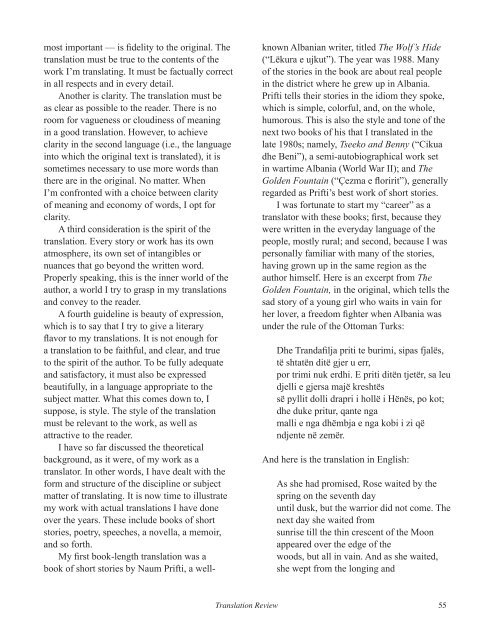Table of contents - The University of Texas at Dallas
Table of contents - The University of Texas at Dallas
Table of contents - The University of Texas at Dallas
You also want an ePaper? Increase the reach of your titles
YUMPU automatically turns print PDFs into web optimized ePapers that Google loves.
most important — is fidelity to the original. <strong>The</strong><br />
transl<strong>at</strong>ion must be true to the <strong>contents</strong> <strong>of</strong> the<br />
work I’m transl<strong>at</strong>ing. It must be factually correct<br />
in all respects and in every detail.<br />
Another is clarity. <strong>The</strong> transl<strong>at</strong>ion must be<br />
as clear as possible to the reader. <strong>The</strong>re is no<br />
room for vagueness or cloudiness <strong>of</strong> meaning<br />
in a good transl<strong>at</strong>ion. However, to achieve<br />
clarity in the second language (i.e., the language<br />
into which the original text is transl<strong>at</strong>ed), it is<br />
sometimes necessary to use more words than<br />
there are in the original. No m<strong>at</strong>ter. When<br />
I’m confronted with a choice between clarity<br />
<strong>of</strong> meaning and economy <strong>of</strong> words, I opt for<br />
clarity.<br />
A third consider<strong>at</strong>ion is the spirit <strong>of</strong> the<br />
transl<strong>at</strong>ion. Every story or work has its own<br />
<strong>at</strong>mosphere, its own set <strong>of</strong> intangibles or<br />
nuances th<strong>at</strong> go beyond the written word.<br />
Properly speaking, this is the inner world <strong>of</strong> the<br />
author, a world I try to grasp in my transl<strong>at</strong>ions<br />
and convey to the reader.<br />
A fourth guideline is beauty <strong>of</strong> expression,<br />
which is to say th<strong>at</strong> I try to give a literary<br />
flavor to my transl<strong>at</strong>ions. It is not enough for<br />
a transl<strong>at</strong>ion to be faithful, and clear, and true<br />
to the spirit <strong>of</strong> the author. To be fully adequ<strong>at</strong>e<br />
and s<strong>at</strong>isfactory, it must also be expressed<br />
beautifully, in a language appropri<strong>at</strong>e to the<br />
subject m<strong>at</strong>ter. Wh<strong>at</strong> this comes down to, I<br />
suppose, is style. <strong>The</strong> style <strong>of</strong> the transl<strong>at</strong>ion<br />
must be relevant to the work, as well as<br />
<strong>at</strong>tractive to the reader.<br />
I have so far discussed the theoretical<br />
background, as it were, <strong>of</strong> my work as a<br />
transl<strong>at</strong>or. In other words, I have dealt with the<br />
form and structure <strong>of</strong> the discipline or subject<br />
m<strong>at</strong>ter <strong>of</strong> transl<strong>at</strong>ing. It is now time to illustr<strong>at</strong>e<br />
my work with actual transl<strong>at</strong>ions I have done<br />
over the years. <strong>The</strong>se include books <strong>of</strong> short<br />
stories, poetry, speeches, a novella, a memoir,<br />
and so forth.<br />
My first book-length transl<strong>at</strong>ion was a<br />
book <strong>of</strong> short stories by Naum Prifti, a well-<br />
known Albanian writer, titled <strong>The</strong> Wolf’s Hide<br />
(“Lëkura e ujkut”). <strong>The</strong> year was 1988. Many<br />
<strong>of</strong> the stories in the book are about real people<br />
in the district where he grew up in Albania.<br />
Prifti tells their stories in the idiom they spoke,<br />
which is simple, colorful, and, on the whole,<br />
humorous. This is also the style and tone <strong>of</strong> the<br />
next two books <strong>of</strong> his th<strong>at</strong> I transl<strong>at</strong>ed in the<br />
l<strong>at</strong>e 1980s; namely, Tseeko and Benny (“Cikua<br />
dhe Beni”), a semi-autobiographical work set<br />
in wartime Albania (World War II); and <strong>The</strong><br />
Golden Fountain (“Çezma e floririt”), generally<br />
regarded as Prifti’s best work <strong>of</strong> short stories.<br />
I was fortun<strong>at</strong>e to start my “career” as a<br />
transl<strong>at</strong>or with these books; first, because they<br />
were written in the everyday language <strong>of</strong> the<br />
people, mostly rural; and second, because I was<br />
personally familiar with many <strong>of</strong> the stories,<br />
having grown up in the same region as the<br />
author himself. Here is an excerpt from <strong>The</strong><br />
Golden Fountain, in the original, which tells the<br />
sad story <strong>of</strong> a young girl who waits in vain for<br />
her lover, a freedom fighter when Albania was<br />
under the rule <strong>of</strong> the Ottoman Turks:<br />
Dhe Trandafilja priti te burimi, sipas fjalës,<br />
të sht<strong>at</strong>ën ditë gjer u err,<br />
por trimi nuk erdhi. E priti ditën tjetër, sa leu<br />
djelli e gjersa majë kreshtës<br />
së pyllit dolli drapri i hollë i Hënës, po kot;<br />
dhe duke pritur, qante nga<br />
malli e nga dhëmbja e nga kobi i zi që<br />
ndjente në zemër.<br />
And here is the transl<strong>at</strong>ion in English:<br />
As she had promised, Rose waited by the<br />
spring on the seventh day<br />
until dusk, but the warrior did not come. <strong>The</strong><br />
next day she waited from<br />
sunrise till the thin crescent <strong>of</strong> the Moon<br />
appeared over the edge <strong>of</strong> the<br />
woods, but all in vain. And as she waited,<br />
she wept from the longing and<br />
Transl<strong>at</strong>ion Review 55

















